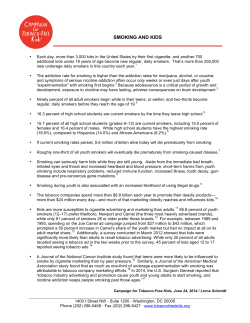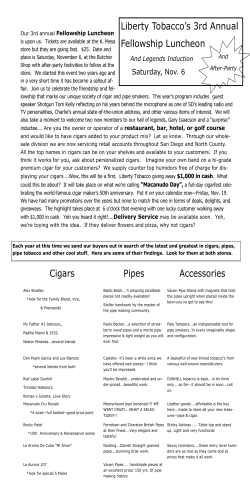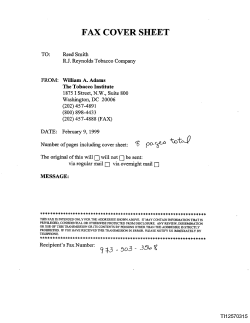
How to Measure Smoking Cessation among Youth
YTCC LEARNINGS RESOURCE SHEET How to Measure Smoking Cessation among Youth The Department of Health and Human Service’s Healthy People 2020 outlines national targets for reducing tobacco use and increasing quit attempts by young smokers (Grades 9-12). These objectives include reducing the use of tobacco products in the past month from 26.0% to 21.0% (Objective TU-2), reducing cigarette smoking in the past month from 19.5% to 16.0% (Objective TU-2.2), and increasing the percentage of adolescent smokers who have made a quit attempt in the past year from 58.5% to 64.0% (Objective TU-7).1 The need to measure and monitor smoking cessation among youth is more important than ever because effective cessation interventions now exist for young smokers. The United States Public Health Services’ clinical practice guideline Treating Tobacco Use and Dependence: 2008 Update recommends for the first time that adolescent smokers be provided with counseling interventions to aid them in quitting smoking.2 :: EXISTING RESOURCES FOR MEASURING SMOKING CESSATION AMONG YOUTH While there is no standard set of evaluation indicators or measures to assess smoking cessation behaviors among youth, there are several key documents and resources available on this topic. The following list is not exhaustive, but is representative of what is commonly used to guide evaluation and surveillance efforts. Evaluation Resources • Canadian Tobacco Control Research Initiative3 available at: http://www.youthtobaccocessation.org/ Uploads/PDF/Indicators_YouthCessation_ Phase2_11_08.pdf Health Canada commissioned a multi-phase project to facilitate the identification, selection, and adoption of standardized indicators for the evaluation of youth cessation programs. During this project, experts succeeded in making recommendations for a set of four core measurement items to be included in a minimum data set upon validation. • Helping Young Smokers Quit (HYSQ)4 available at: http://helpingyoungsmokersquit.org/toolkit The HYSQ initiative is a multi-phase project that addresses the need to disseminate effective cessation programs for young smokers. HYSQ developed an evaluation toolkit for youth smoking cessation programs. The toolkit provides program administrators with surveys that can be given to participants in cessation programs. It also includes • Key Outcome Indicator Report (KOI)5 available at: http://www.cdc.gov/tobacco/tobacco_ control_programs/surveillance_evaluation/ key_outcome/index.htm The KOI provides information on 120 key outcome indicators for evaluation of statewide comprehensive tobacco prevention and control programs. The guide includes indicators to evaluate activities related to increasing cessation among adults and youth. tools to create and analyze reports from pre-program, post-program, and follow-up surveys, and provides suggestions for interpreting results. YOUTH TOBACCO CESSATION COLLABORATIVE Surveillance Resources • National Youth Tobacco Survey (NYTS)8 • Monitoring the Future (MTF)6 available at: http://monitoringthefuture.org/ • Question Inventory on Tobacco (QIT)10 available at: http://apps.nccd.cdc.gov/qit/quickSearch.aspx available at: http://www.cdc.gov/tobacco/data_statistics/ surveys/nyts/index.htm MTF provides annual data on behaviors, knowledge, attitudes, and values related QIT, a web-based tool developed by Centers for Disease Control and Prevention’s Office on Smoking and Health, categorizes more than 6,000 tobacco-related questions. This site can be used to collect information on survey questions used in the past, locate available data for secondary analyses, and gather ideas for future instrument development. The NYTS, a survey of middle school to the use of an array of both illicit and licit and high school students in the United drugs among secondary school students, States, provides estimates of usage for college students, and young adults. various tobacco products and several Tobacco related indicator topics include indicators related to smoking cessation cigarette use, initiation, cessation behavior, goals, attitudes, and behaviors. The and brand preference among others. survey has been conducted since 2000. • National Youth Smoking Cessation Survey (NYSCS)7 available in 2011 at: http://www.icpsr.umich.edu/icpsrweb/ICPSR/ • National Survey on Drug Use or Health (NSDUH)9 The NYSCS was a two-year longitudinal telephone study of adolescent and young adult cigarette smokers aged 1624 years. The study’s goal was to provide insight into adolescent and young adult quitting behavior, track changes available at: http://www.icpsr.umich.edu/icpsrweb/ICPSR/ • Youth Risk Behavior Surveillance System (YRBS)11 The NSDUH provides data on the prevalence, patterns, knowledge and attitudes, and consequences of drug and alcohol use and abuse in the United States including tobacco. in quitting behavior over time, and clarify preferences for different types of assisted quitting interventions. available at: http://www.cdc.gov/HealthyYouth/yrbs/index.htm The YRBS is a nationally representative survey of students in grades 9 through 12. Conducted biennially, the YRBS serves as the data source for measuring progress toward meeting the Healthy People 2010 objectives to reduce tobacco and increase quit attempts by adolescent smokers. REFERENCES 1. U.S. Department of Health and Human Services 4. Helping Young Smokers Quit. Program 8. Centers for Disease Control and Prevention. (2011). Healthy People 2020. Available at: http://www. Evaluation Toolkit. Available at: http:// National Youth Tobacco Survey. Available at: healthypeople.gov/2020/default.aspx helpingyoungsmokersquit.org/toolkit http://www.cdc.gov/tobacco/data_statistics/ 2. Fiore MC, Jaén CR, Baker TB, et al (2008). Treating 5. Starr G, Rogers T, Schooley M, et al (2005). Key surveys/nyts/index.htm Tobacco Use and Dependence: 2008 Update. Clinical Outcome Indicators for Evaluating Comprehensive Practice Guideline. Rockville, MD: U.S. Department of Tobacco Control Programs. Atlanta, GA: Centers Consortium for Political and Social Research. Health and Human Services. Public Health Service. for Disease Control and Prevention. Available at: Available in 2011 at: http://www.icpsr.umich.edu/ Available at: http://www.surgeongeneral.gov/ http://www.cdc.gov/tobacco/tobacco_control_ tobacco/treating_tobacco_use08.pdf programs/surveillance_evaluation/key_outcome/ 3. Manske S, Cressman Zehr W, Lovato CY, et al (2007). Indicators and measurement items for outcome index.htm 6. University of Michigan: Institute for Social evaluation of youth smoking cessation interventions: Research. Monitoring the Future. Phase II – Youth Consultation Sessions and Expert Available at: http://monitoringthefuture.org/ Review Panel Toronto: Report from the Canadian Tobacco Control Research Initiative to the Office of Programs and Mass Media, Tobacco Control Programme, Health Canada. Available at: http://www. youthtobaccocessation.org/Uploads/PDF/Indicators_ YouthCessation_Phase2_11_08.pdf 7. University of Michigan: Inter-University Consortium for Political and Social Research. Available in 2011 at: http://www.icpsr.umich.edu/ icpsrweb/ICPSR/ 9. University of Michigan: Inter-University icpsrweb/ICPSR/ 10. Centers for Disease Control and Prevention. Question Inventory on Tobacco (QIT). Available at: http://apps.nccd.cdc.gov/qit/ quickSearch.aspx 11. Centers for Disease Control and Prevention. Youth Risk Behavior Survey. Available at: http://www. cdc.gov/HealthyYouth/yrbs/index.htm YOUTH TOBACCO CESSATION COLLABORATIVE
© Copyright 2026





















